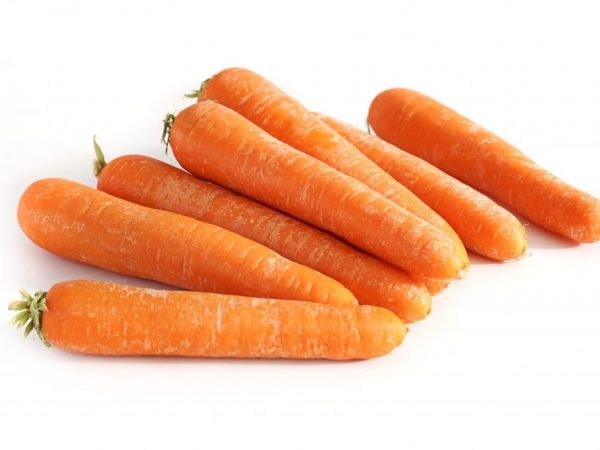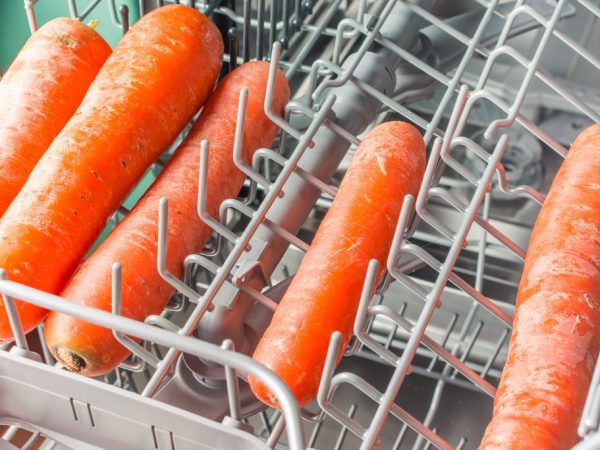Characteristics of Nantes carrots
Carrots of Nantes have established themselves thanks to their stable yield. It is a medium early variety that ripens in 80 to 100 days. There are several varieties of this culture: improved Nantes carrots, Gavrish, Nantes red carrots.

Characteristics of Nantes carrots
Description of the variety
Table of characteristics of varieties.
| Name | Characteristics of the fetus | Using | Yield | Features of the |
| Carrot of Nantes (Gavrish) | Weight - up to 100 g. Cylindrical shape, elongated, with a blunt end. Fruit diameter - up to 5 cm. The pulp is juicy, the taste is delicate. The length of the root is about 16 cm. The color is bright orange. It contains a high percentage of carotene (20%). | It is used both for fresh consumption and for processing. Recommended for children and for medicinal purposes. | 6.5 kg per m² | Long shelf life, good presentation. |
| Nantes improved carrot (sugar) | Weight - 160 g. The shape is cylindrical, elongated. The pulp is juicy. The orange-colored root vegetable is sweet. | It is used for fresh consumption, processing and freezing. | 7 kg per m² | The variety bears fruit regularly and has a long shelf life. |
| Nantes red carrot | Weight - up to 160 g. Length - 16 cm. Diameter - up to 6 cm. The shape is even, cylindrical. The taste is sweet, the flesh is juicy and dense. The color is red-orange. | Used for fresh consumption and for cooking. | 6.5 kg per m² | Stored for a long time without losing taste. |
The first shoots appear 50-55 days after sowing. Full ripeness occurs on the 90-120th day.
Planting and growing
The place is chosen sunny, in the shade and partial shade, the root crop loses its taste, the shoots sprout for a long time and turn pale. The Nantes carrot variety has not been planted in the same place for several years in a row.
Also, it is not planted in places where crops such as dill, parsnips, celery or parsley were previously grown. Good cultural precursors are:
- a tomato;
- bow;
- garlic;
- cucumber;
- potato.
Sowing
Carrots of Nantes, according to the description, have a good yield, therefore they are planted twice per season. The first sowing is performed in early April. The second - at the end of July, so that the fruits ripen before the onset of frost.
To get an early harvest in spring, the vegetable is sown in late autumn. When planting seeds, the weather must be dry, and the soil must be specially prepared. For this, the soil is loosened and the places for sowing are marked. The seeds are mixed with sand and sprinkled with soil. For overwintering, a special fiber is used to cover the sowing sites.
After the first shoots appear in the spring, the soil between the rows is loosened so that the carrot root system receives the required amount of oxygen. This procedure also reduces weeds. The early carrots are harvested in May.
Calibration
Calibration of Nantes carrots is carried out prior to planting the seeds. For this, the planting material is transferred to a container with warm water overnight.
In the morning, they examine the seeds: those that have surfaced are incapacitated - they are thrown away. Healthy ones will be at the bottom of the container. The tested seeds are dried and sown.
Dry the seeds with a towel. The towel is placed on a dish, after which the proven planting material is distributed in a thin layer. This dish is placed in a plastic bag and tied to keep the seeds moist. Store - 3 days. Later, the seeds begin to germinate and are moved to dry.
Sowing by watering
Gardeners use watering to plant carrots. Seeds and water are placed in a container, after which the culture is sown along the furrows.
The depth of the planting pit is 2-3 cm. There should be a distance of at least 15 cm between the rows.
Description of care

Smooth carrots with proper care
During ripening, the sprouted shoots of Nantes carrots are resistant to cold, but the temperature should not be lower than 0 ° C. To do this, determine the timing of germination before sowing, so that the root crop does not lose its qualities.
Low air temperature slows down the development of the crop. Only leaves develop. Carrots are dry, tasteless and not suitable for consumption.
Weeding
Weeding is carried out regularly, every 10-14 days. This is "dry watering" for the crop, the fruits will be even, and the garden - neat.
When the seed umbrella reaches 20 cm, the crops break through. All excess plants in the garden are removed manually. Leave no more than 4 cm between vegetables. If you take this rule into account, the harvest will be tastier and larger.
Watering
The first week after germination is most important for carrots. At this time, abundant watering is performed. Watering frequency is once a week. 10 liters of water are used per 1 m².
For adult plants, watering is done less often - twice a month. In hot weather, seedlings dry out without watering.
Top dressing
Nantes carrots are fed twice during the growing period. For this, special mineral fertilizers are used:
- urea (10 g);
- potassium salt (15 g);
- superphosphate (25 g).
This composition of fertilizers is designed for 1 sq. m. The first feeding is carried out when 4 leaves have risen. The second is at the end of July.
Spraying
Carrots are sprayed in two ways: chemical and biological agents. For chemical treatment, agents that protect against parasites and pests are used ("Arrivo", "Karate"). The first spraying is carried out when the seed umbrella consists of 4 leaves. The second - on the 21st day after the first, and the third - only if necessary (on the 21st day after the second).
There are folk remedies for protecting culture. Wormwood solution is the most effective of these. For its preparation, only collected wormwood (5 l) is used. It is poured with boiling water and left to infuse overnight. The next morning the herbal infusion is filtered through cheesecloth and diluted with water (10 l).
The infusion is used to fight parasites. They are sprayed not only with carrots, but also with other crops (currants, raspberries).
Pests and diseases
Carrots of Nantes rarely get sick. The most common diseases are phomosis and alternaria. For the prevention of these ailments, Bordeaux liquid is used. Carrot leaves are treated with this drug.
The carrot fly destroys the fruit. When the leaves begin to curl and curl, the insect parasitizes. For prevention, they regularly weed the beds, get rid of weeds in time and avoid dense thickets. To combat insects, the preparations "Intavir" and "Actellik" are used.
Conclusion
The Nantes carrot variety, according to the description, is resistant to frost, is not capricious to care for and takes root well in any climatic conditions. A feature of crop care is timely weeding, so that the plant feeds on oxygen, and the fruit actively develops.
Nantes carrots have a large amount of carotene in the composition - 20%. It is used for fresh consumption, as well as for preparing meals and juices.


